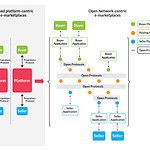Antariksh Matters #1: Small Launchers and Small Windows of Opportunity
— Pranav R Satyanath
The small satellite launch vehicle market has a new player - Firefly Aerospace. The US-based private company on Saturday (October 1st 2022) conducted the first successful launch of its rocket Firefly Alpha. The company attempted a launch in September 2021, which failed to get to orbit. Today, Firefly is one of only four private NewSpace companies in the world which provide dedicated small-satellite launch service. The other three being Rocket Lab, Virgin Orbit and Astra (the last of the three companies is an interesting case).
Firefly’s Alpha launch vehicle can carry a payload of just over 1 ton to low-Earth orbit (LEO) and 750 kilograms to Sun Synchronous Orbit (SSO). This puts Alpha in the same category as the Polar Satellite Launch Vehicle (PSLV), which is the workhorse of the Indian Space Research Organisation (ISRO). The Alpha launch vehicle is powered by four liquid-fuelled turbopump engines that use RP-1 (highly refined kerosene) and liquid oxygen (LOx). The second stage is powered by a single liquid-fuelled RP-1/LOx engine optimised for vacuum.
The company is one of the few success stories in the highly competitive launch market, and success did not come easy. Firefly was founded as Firefly Space Systems in 2014,but the company went bankrupt and liquidated in 2017 and its assets were purchased by Ukrainian venture capitalist (also a tech entrepreneur) Max Polyakov and his company, Noosphere Ventures. Unfortunately, Polykov could only stand at a distance and watch Firefly’s success as he was forced to sell his shares after Russia’s invasion of Ukraine.
A tough time for small launch companies
Not all companies witness success by the likes of Firefly. In December 2019, Vector Launch filed for bankruptcy before it could attempt a full orbital launch of its Vector-R rocket. The company has undergone restructuring and is preparing to begin suborbital flight tests. Another US-based company, Astra, has been attempting to launch its rocket into orbit since 2020, with very little success, leaving the company to abandon its Rocket 3.3 and move to a new design called Rocket 4 instead. Oher companies in the US
India’s own attempt to launch the Small Satellite Launch Vehicle (SSLV) failed to place its payloads in orbit after a malfunction in its sensors. The SSLV is operated by ISRO’s newly- established commercial arm called NewSpace India Limited (NSIL). SSLV, unlike other launch vehicles, uses solid fuel in the first three stages. The final stage is a liquid-fuelled velocity trimming module. SSLV is India’s attempt to enter the small satellite launch market, offering a launch-on-demand service to carry upto 500 kg to LEO or 300 kg to sun synchronous orbit.
Several other launch companies around the world are preparing to tap into the growing small satellite market. Yet, it is unclear how many of these companies will survive in the coming years. More importantly, it is unclear whether these private entities have overestimated the market for small satellites, as a drop in demand puts at risk the sustainability of these companies.
Small launch vehicles for India
Indian private launch companies are not far behind the world competitors. Two companies in particular, Agnikul and Skyroot, have risen to the occasion in their attempt to fulfil India’s satellite launch demands. As an aspiring space power, India can not compete in the global space market by making an average of five launches a year. It requires dozens of launches (along with many many more satellites) to stay competitive on both commercial and national security grounds. India’s forthcoming new space policy (long overdue and still nowhere in sight) must make it conducive for private launch providers to operate and thrive. ISRO, meanwhile, must focus its efforts on improving the reliability of its GSLV series of heavy-lift rockets and allow privateers to cater to the small satellite market needs.
Siliconpolitik: India’s Semiconductor Policies v2.0
— Pranay Kotasthane
Earlier this week, the Union Cabinet approved modifications to three of the four schemes introduced in December 2021 for developing a domestic semiconductor ecosystem. Several news websites have claimed that with the government “sweetening the deal”, investments in this sector will be more forthcoming. I agree, but not without some fundamental reservations. Here’s why.
Semiconductor Fabs
To attract chip manufacturing companies, the original programme promised up to 50% upfront financial support for leading-edge nodes (28 nanometres and below). The promised fiscal support for trailing-edge nodes employing older technologies dropped commensurately, going down to 30% for a fab that produces chips at the 45-65 nanometre nodes. (The node size is a rough measure for the size of a building block in a chip. The smaller that number, the more building blocks that can be packed in the same area resulting in higher performance).
Under the new scheme, the government promises upfront fiscal support of 50% for all node sizes. The change reflects two realities. First, trailing-edge fabs are crucial for India. The demand for older node sizes will not disappear anytime soon. Future applications such as 5G radios and electric vehicles will continue to require manufacturing at these nodes. Most current defence applications also require trailing-edge chips.
Second, many countries are wooing the leading-edge node foundries with much larger incentive packages. Companies such as TSMC are being courted by all major powers, and it’s unlikely they will pick India for the most-advanced nodes. India’s chances are better for securing older technologies.
Display Fabs
Most display panel manufacturers are located in East Asia — companies from China, Taiwan, South Korea, and Japan dominate this industry. The scheme was designed with the explicit aim of import substitution. The original scheme promised up to 50% upfront financial support subject to a cap of ₹12,000 crores. As part of the changes, this upper cap has been struck off.
To me, this scheme didn’t make sense even when it was announced. I have four reasons for the scepticism.
Even during the high peak of supply chain disruptions during COVID-19, there was no shortage of display panels, indicating that there are no constraints to increasing production, as is the case for chips. (The only shortage related to displays was for the driver chip, not the panels by themselves).
Apart from China and Taiwan, South Korea and Japan have leadership in specific segments of displays. So we aren’t dependent on one vulnerable source, as in the case of chips.
Import dependence on China won’t go away. Even if these fabs manufacture displays in India, the input materials will have to be imported from elsewhere. So the bottlenecks will shift but don’t disappear.
The industry is moving to newer technologies apart from LCDs and AMOLEDs. Samsung is focusing on Quantum-dot displays instead of LCDs. The scheme might be able to get old-tech here, but for newer technologies, imports might continue.
Thus, to spend ₹12000 crores for a product in the pursuit of a failed notion of import substitution doesn't justify the opportunity costs. Moreover, removing the upper cap after Vedanta-Foxconn got into this game raises concerns about rent-seeking — the tendency of businesses to distort policies to serve their own interests.
Assembly, Test, Packaging Units, and Specialised Low-volume Fabs
For assembly, test and packaging firms, & compound fabs, the promised financial support has increased substantially, from 30% to 50%. More importantly, the original scheme allowed disbursal once a facility had begun production. Under the modified scheme, the financial support will be upfront. Prepaid, not postpaid.
These changes again warrant scrutiny. Is it another case of rent-seeking?
At the margin, I am okay with the changes in this segment. India has a potential advantage because of the need for a large, mid-level trained workforce for this segment of the supply chain, in comparison to conventional semiconductor fabs.
Semiconductor Design
Surprisingly, there were no modifications in the one area where India does have a comparative advantage - semiconductor design and design services. The capital requirement for this segment is at least two orders of magnitude lower than the first three segments. And yet, the response to the scheme for encouraging design firms seems less than lukewarm. We propose two changes in the policy for that segment in an article for Hindustan Times earlier this month:
To receive deployment-linked incentives under the current scheme, a design firm has to be registered in India with a 50% local stake. That clause could be watered down. Companies should qualify as long as the workforce is majorly Indian and the development happens here.
Reducing tariff and non-tariff barriers are also crucial for India’s semiconductor design companies to increase operations in India.
On both these counts, the status quo prevails.
To summarise, the modifications reflect the government’s seriousness in attracting investment in this sector. Through these changes, the government is acknowledging that India must start its chip manufacturing journey at the lower end and climb its way up. Getting good at this game takes a couple of decades. At the same time, a thin line separates responsive government policies from regulatory capture by businesses. All industrial policies run this risk, and we need to be vigilant.
Antariksh Matters #2: Planetary Defence and National Defence
— Aditya Ramanathan
On September 26, NASA concluded what it called “the world’s first planetary defense technology demonstration” in a spectacular collision. Ten months after it was first launched, NASA’s 570 kilogram Double Asteroid Redirection Test (DART) spacecraft smashed into the asteroid Dimorphos. The collision occurred 11 million kilometres from Earth.
Dimporphos is technically a 160 metre-long ‘asteroid moonlet’ - called so because it orbits a larger asteroid named Didymos. While neither rock is headed towards Earth, the DART mission sought to establish the ability to deflect an asteroid from its trajectory.
The DART spacecraft was launched in November 2021 from a SpaceX Falcon 9 rocket and Johns Hopkins Advanced Propulsion Laboratory (JHUAPL) managed the mission. The apparent success of DART is likely to prompt more ‘planetary defence’ missions. According to the latest decadal survey published by the US-based National Academies, NASA’s annual budget for planetary defence is more than $160 million. NASA has tracked about 27,000 near Earth objects (NEOs) using this funding. Yet this is barely enough to track naturally occurring threats from space. In particular, NEOs that are between 30-140 metres in size and typically collide with the Earth once every century, can be hard to detect. One such celestial body was responsible for the 1908 Tunguska event.
Ambitious Proposals, Enduring Suspicions
While the DART mission was a kinetic collision, such interventions may not suffice for every contingency. While no civilisation-killing NEOs are likely to be headed Earth’s way anytime soon, smaller NEOs that can still result in catastrophes may be detected too late for deflection. Also, kinetic collisions may risk creating fragments large enough to survive reentry and cause damage on Earth. The most common proposal for dealing with such contingencies is using explosive nuclear devices. One scientific study from 2021 concluded that such devices were likely to be useful in destroying major NEOs headed towards Earth.
While it may be prudent to seriously examine the options available, NASA’s planetary defence project is not without political implications. Any spacefaring capability that can destroy through kinetic collision, or worse yet, nuclear explosives, has obvious military implications. This is especially so because, as we have argued, space warfare is still primitive in character, depending on dual-use capabilities rather than specialised weapons or platforms.
While the military applications of DART-like missions are unclear and fantastical at the moment, states are not known to take chances on such matters. For reasons of both survival and prestige, America’s rivals may initiate their own planetary defence programmes in the near future.
Our Reading Menu
[Book] A History of Near-Earth Objects Research by Erik M. Conway, Donald K. Yeomans, and Meg Rosenburg
[Report] Forecasting th A History of Near-Earth Objects Researche future impact of emerging technologies on international stability and human security by Marina Favaro, Neil Renic and Ulrich Kühn
[Research Article] One if by Land, and Two if by Sea: Cross-Domain Contests and the Escalation of International Crises by J Andrés Gannon











Share this post